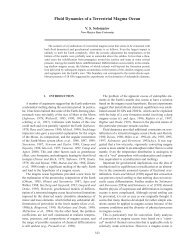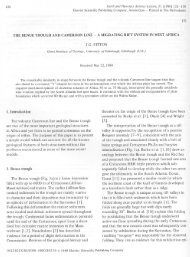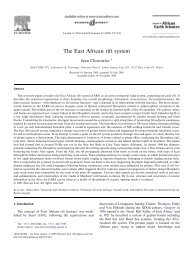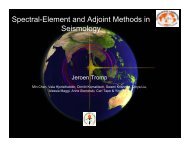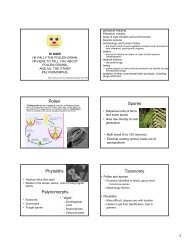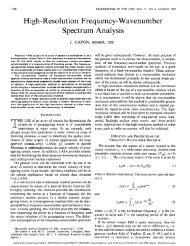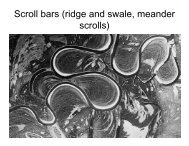Directional Recording of Swell from Distant Storms - Department of ...
Directional Recording of Swell from Distant Storms - Department of ...
Directional Recording of Swell from Distant Storms - Department of ...
Create successful ePaper yourself
Turn your PDF publications into a flip-book with our unique Google optimized e-Paper software.
526 W. H. MUNK, G. R. MILLER, F. E. SNODGRASS AND N. F. BARBEROf course the set <strong>of</strong> values al, oa2 and 3 is not unique. Any <strong>of</strong> them may be varied by someintegral multiple <strong>of</strong> 2ir. This leads to an infinite set <strong>of</strong> points lo, mo. To chose between themone needs other geophysical information, usually a dispersion formula that suggests whatthe wave number ko- (12+m2)1is likely to be at the frequency that is being considered.It is <strong>of</strong> interest to note that if one applies the least-square error method to only a singlepair <strong>of</strong> instruments, the expression for E' contains only a single sinusoid in 1, m; and thevalues <strong>of</strong> 10, mO that give the best fit have loci that are just the 'crest' lines <strong>of</strong> this sinusoid in1, m space. If one uses wave number, ko, and direction, aO, instead <strong>of</strong> lo and mo, the relationbetween ko and ao is precisely that obtained previously in (5.3).(c) A best-fitting pair <strong>of</strong> wave trainsThe information given by the seven C and Q values is more than enough to determine asingle wave train for this has only three unknown characters, AO, 10, and mo. Indeed oneshould be able to fit two wave trains, determining six unknown characters. Methods <strong>of</strong>doing this were devised but were not much used in the present experiments. These methodswill be outlined, however, since they may be <strong>of</strong> use in other work.(1) If one choses any two points, say (11, ml) and (12, M2) in wave-number space, then thebest amplitudes to chose for these waves are A1 and A2, that fulfil the relationsEl =A1+F12A2, E2 - A2+F21A1Here E' and E' are the values calculated for wave numbers (1, ml) and (12, M2) by the conventionalmethod <strong>from</strong> the observed C's and Q's. The factor F12 is the E' that would becalculated for wave numbers (1k, ml) using C's and Q's that would arise <strong>from</strong> a single wavetrain <strong>of</strong> unit power having wave numbers (12, M2) .The best fit to the observed C's and Q's is obtained when one choses (li, ml) and (12, M2)so as to maximizeA E +A2EThese results readily follow by arguments like those used in ?(b), for deciding the best fitfor a single wave train.(2) If the wave data rise solely <strong>from</strong> two well-directed wave trains, then the C's and Q'swill be found to obey the relationTo ( T2 0 _ T2- T2- T2) +2TIT2T3 COS (*l + 22 + *3) -0 = ? (7.7 (7-7)where T and * are defined by Tnexp i' -Cn-i Qn.One may write A for the power <strong>of</strong> the first wave train and cx,, a23 c3 for the phase differencesit alone would display at the three pairs <strong>of</strong> instruments. Similarly B, %l, fl2, /? may representthe power and the phase differences <strong>of</strong> the second wave train. Then it must follow that theobserved C's and Q's when both waves are present are merely the sums <strong>of</strong> what would beobserved with each wave alone, orTo =A+B,T1 expi!rl = Aexpi lr+Bexpi!r1,T2expii2 A expi#2 2+B expi !2,T3expii3 = Aexpi !33+Bexpi'3.




